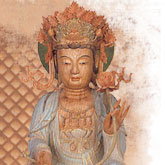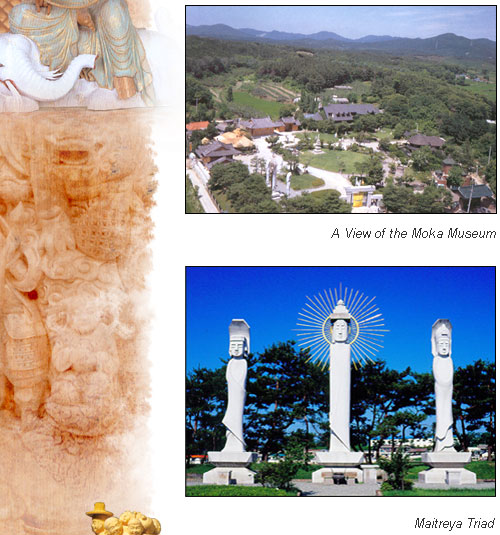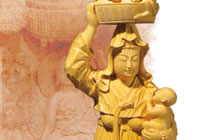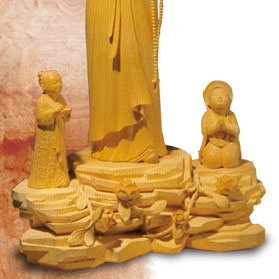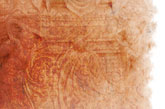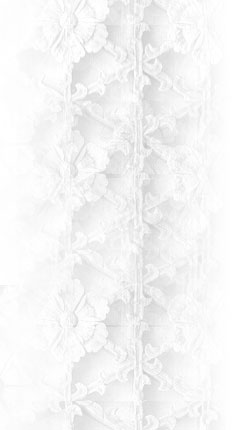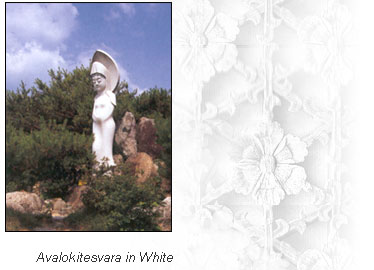Apart from his artistic creations, Park Chan-soo has also shown a keen interest in collecting Buddhist cultural
objects. After he amassed more than 6000 pieces, among them three items designated as “treasures” by the Korean
government, he founded the Moka Museum in 1993, dedicated to Buddhism. This museum, consisting of exhibition
halls, a Buddha sculpture garden, a prayer hall and a research center, displays great works of Buddhist art, including
rare ancient relics as well as Park’s own Buddha sculpture. It captivates visitors not only with its fine collection
surrounded by picturesque surroundings but also by the tranquil ambiance created by the compassion of Lord Buddha.
As the curator of the museum, he gains inspiration for his own Buddha sculpture through the act of collecting
wonderful Buddhist fine arts, both traditional and contemporary.
 In 1990, Park Chan-soo began to introduce new In 1990, Park Chan-soo began to introduce new
 forms to his Buddha sculpture and interwove them with forms to his Buddha sculpture and interwove them with
 traditional subjects. The result was a combination of traditional subjects. The result was a combination of
 ancient customs with modern aestheticism in a single ancient customs with modern aestheticism in a single
 piece, for example, innocent child monks and jangseung, piece, for example, innocent child monks and jangseung,
 the carved wooden poles worshiped as village guardians the carved wooden poles worshiped as village guardians
 by the common people of Korea. The stone Maitreya by the common people of Korea. The stone Maitreya
 Triad and the Avalokitesvara in White displayed in Triad and the Avalokitesvara in White displayed in
 the museum’s open-air exhibition area are highly the museum’s open-air exhibition area are highly
 acclaimed by critics, as the carvings brought a new acclaimed by critics, as the carvings brought a new
 style to Buddha sculpture by integrating traditional style to Buddha sculpture by integrating traditional
 iconic features with the conventional beauty of iconic features with the conventional beauty of
 jangseung (Korean wooden totem pole). jangseung (Korean wooden totem pole).
Looking back on the life of Park Chan-soo as an artist of wooden Buddha sculptures, many may say that he knew
more about wood and trees than anyone else on Earth. In order to give life back to the tree so that it can be reawakened
 as a living work of art, the artist’s mind, heart and soul needs to belong to the wood, and in a sense become
as a living work of art, the artist’s mind, heart and soul needs to belong to the wood, and in a sense become
 the wood. Master Wooden Buddha Sculptor Park has found his life lies within the grain, the fragrance and
the wood. Master Wooden Buddha Sculptor Park has found his life lies within the grain, the fragrance and
 the spirit of this natural wonder and will continue to live with wood for as long as trees exist in this world.
the spirit of this natural wonder and will continue to live with wood for as long as trees exist in this world.
 The
appearance of an artist wielding an adz to a block of wood is intense
and aggressive―his whole body The
appearance of an artist wielding an adz to a block of wood is intense
and aggressive―his whole body
 vibrates from the sheer force he exerts, his eyes alight with powerful energy, and his mind is completely engrossed
vibrates from the sheer force he exerts, his eyes alight with powerful energy, and his mind is completely engrossed
 in the
task before him―and those watching may wonder if the artist will be taken
over by his own fierce passion. in the
task before him―and those watching may wonder if the artist will be taken
over by his own fierce passion.
 Whenever the adz strikes the wood as if in time to music, the spectators’ souls start to beat, “Thump!
Whenever the adz strikes the wood as if in time to music, the spectators’ souls start to beat, “Thump!
 Thump!” until they become part of the sound, part of the energy, part of the work being carved. By the
Thump!” until they become part of the sound, part of the energy, part of the work being carved. By the
 time the audience has become transfixed by the flashing adze, the formidable power, and the rhythmic
time the audience has become transfixed by the flashing adze, the formidable power, and the rhythmic
 reverberations, the performance ends and the slab of wood has been transformed into work of art.
reverberations, the performance ends and the slab of wood has been transformed into work of art.
 The fine art of carving is like a theatrical performance, and Park’s remarkable gift is no The fine art of carving is like a theatrical performance, and Park’s remarkable gift is no
 exception. In fact, Park sometimes stages a sculpting presentation, in which he carves a piece
exception. In fact, Park sometimes stages a sculpting presentation, in which he carves a piece
 in time with famous musicians, dancers and painters, an amazing event that is not only famous
in time with famous musicians, dancers and painters, an amazing event that is not only famous
 in Korea but all over the world. As soon as the sounds of Park Chan-soo carving are fused with
in Korea but all over the world. As soon as the sounds of Park Chan-soo carving are fused with
 the rhythmical gestures of music, dance and painting, his unique dramatic recital comes alive.
the rhythmical gestures of music, dance and painting, his unique dramatic recital comes alive.
Park Chan-soo is a sculptor with an international reputation who has seen his exhibitions held in more than 50
countries worldwide. In fact, one of his works, which he made during his sculptural performance, is displayed at the
Texan farm owned by George W. Bush, President of the U.S.A. But behind his international success as a Buddha
sculptor representing Korean culture are his deep-rooted beliefs and inherent devotion as an Buddhist artist of
Korean tradition. The uniqueness that makes his work different from anyone else in the world originates from this
tradition of Korean woodcarving that has lasted for thousands of years.
 He is not, however, only seeking to revitalize customs alone. He is not, however, only seeking to revitalize customs alone.
 Park Chan-soo, armed with both the spirit of workmanship and
Park Chan-soo, armed with both the spirit of workmanship and
 an artistic vision, does not ignore the mission of appreciating
an artistic vision, does not ignore the mission of appreciating
 and interpreting contemporary ideas and incorporating those
and interpreting contemporary ideas and incorporating those
 views into the preservation of tradition. His achievements in
views into the preservation of tradition. His achievements in
 conserving what is traditional have been enormous indeed,
conserving what is traditional have been enormous indeed,
 and his ability to carve exquisite and elegant details in such
and his ability to carve exquisite and elegant details in such
 award-winning works as the Dharma Seat and the Openwork
award-winning works as the Dharma Seat and the Openwork
 Holder with Floral Motif has been equally so. He continued to
Holder with Floral Motif has been equally so. He continued to
 refine his talents and displayed their aesthetic climax in the
refine his talents and displayed their aesthetic climax in the
 Wooden Buddha Trinity in the Triad Shrine. This masterpiece,
Wooden Buddha Trinity in the Triad Shrine. This masterpiece,
 carved with only one piece of wood using traditional carving
carved with only one piece of wood using traditional carving
 knives and without any help from modern machines, could
knives and without any help from modern machines, could
 not have been created without superior skills and techniques
not have been created without superior skills and techniques
 as well as a deep religious piety and devotion.
as well as a deep religious piety and devotion.
View the master's works
|













